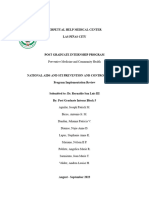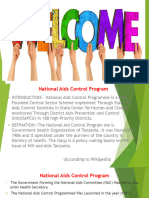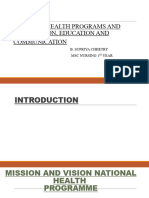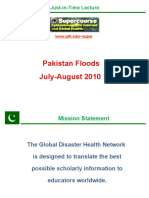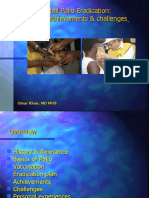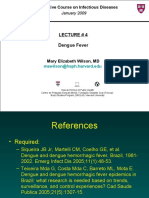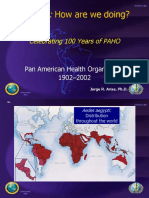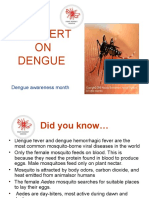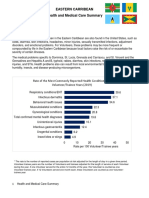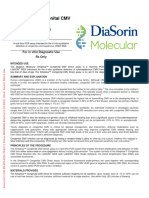0 ratings0% found this document useful (0 votes)
58 viewsNational AIDS Control Program: Dr. Kanupriya Chaturvedi
National AIDS Control Program: Dr. Kanupriya Chaturvedi
Uploaded by
fahimalikThe document summarizes India's National AIDS Control Program (NACP). It discusses the evolution of the program through Phases I, II, and III. The goals of NACP-III are to halt and reverse the HIV epidemic in India by integrating prevention, care, support, and treatment programs. The strategy involves preventing infections through high-risk group interventions, providing care and treatment to more HIV patients, and strengthening infrastructure and monitoring systems.
Copyright:
Attribution Non-Commercial (BY-NC)
Available Formats
Download as PPT, PDF, TXT or read online from Scribd
National AIDS Control Program: Dr. Kanupriya Chaturvedi
National AIDS Control Program: Dr. Kanupriya Chaturvedi
Uploaded by
fahimalik0 ratings0% found this document useful (0 votes)
58 views42 pagesThe document summarizes India's National AIDS Control Program (NACP). It discusses the evolution of the program through Phases I, II, and III. The goals of NACP-III are to halt and reverse the HIV epidemic in India by integrating prevention, care, support, and treatment programs. The strategy involves preventing infections through high-risk group interventions, providing care and treatment to more HIV patients, and strengthening infrastructure and monitoring systems.
Original Title
40351
Copyright
© Attribution Non-Commercial (BY-NC)
Available Formats
PPT, PDF, TXT or read online from Scribd
Share this document
Did you find this document useful?
Is this content inappropriate?
The document summarizes India's National AIDS Control Program (NACP). It discusses the evolution of the program through Phases I, II, and III. The goals of NACP-III are to halt and reverse the HIV epidemic in India by integrating prevention, care, support, and treatment programs. The strategy involves preventing infections through high-risk group interventions, providing care and treatment to more HIV patients, and strengthening infrastructure and monitoring systems.
Copyright:
Attribution Non-Commercial (BY-NC)
Available Formats
Download as PPT, PDF, TXT or read online from Scribd
Download as ppt, pdf, or txt
0 ratings0% found this document useful (0 votes)
58 views42 pagesNational AIDS Control Program: Dr. Kanupriya Chaturvedi
National AIDS Control Program: Dr. Kanupriya Chaturvedi
Uploaded by
fahimalikThe document summarizes India's National AIDS Control Program (NACP). It discusses the evolution of the program through Phases I, II, and III. The goals of NACP-III are to halt and reverse the HIV epidemic in India by integrating prevention, care, support, and treatment programs. The strategy involves preventing infections through high-risk group interventions, providing care and treatment to more HIV patients, and strengthening infrastructure and monitoring systems.
Copyright:
Attribution Non-Commercial (BY-NC)
Available Formats
Download as PPT, PDF, TXT or read online from Scribd
Download as ppt, pdf, or txt
You are on page 1of 42
National AIDS Control
Program
Dr. KANUPRIYA CHATURVEDI
Lesson Objectives
To know about the extent of the problem of
HIV/AIDS in India
To learn about the evolution of India’s
response to HIV/AIDS: phases 1,2, 3 of
NACP(National AIDS Control Program)
To know about the goals, objectives,
strategies of NACP
To know about the achievements of NACP
Dr. KANUPRIYA CHATURVEDI
Global estimates for
Adults and Children, 2008
CATEGORY Estimated Range
People living with HIV 33.4 million 31.1 – 35.8 million
2.7 million 2.4 – 3.0 million
New HIV infections in 2008
Deaths due to AIDS in 2008 2.0 million 1.7 – 2.4 million
Dr. KANUPRIYA CHATURVEDI
HIV estimates for India (2007)
Category Estimation
Total population 1.027 billion
HIV prevalence (15-49 years) 0.34%
HIV prevalence among men (15-49 years) 0.40%
HIV prevalence among women (15-49 years) 0.27%
Number of people living with HIV (adults and
2.31 million
children)
Number of Children living with HIV (>15 years) 3.8% of total
Dr. KANUPRIYA CHATURVEDI
Current Scenario
HIV situation in the country is assessed and monitored
through regular annual sentinel surveillance
established since 1992.
There are 1.8 - 2.9 million (2.31 million) people living
with HIV/AIDS at the end of 2007. The estimated adult
prevalence in the country is 0.34% (0.25% - 0.43%)
and it is greater among males (0.44%) than among
females (0.23%).
The overall HIV prevalence among different population
groups in 2007 continues to portray the concentrated
epidemic in India, with a very high prevalence among
High Risk Groups - IDU (7.2%), MSM (7.4%), FSW
(5.1%) & STD (3.6%) and low prevalence among ANC
clinic attendees (Age adjusted - 0.48%).
Dr. KANUPRIYA CHATURVEDI
Overview
In India, after the first case of HIV was detected in Chennai in
1986, the virus spread rapidly across the nation in both urban
and rural areas.
Since then, the HIV epidemic has traveled a long way,
establishing itself with the greatest speed in the six high
prevalence states of Andhra Pradesh, Maharashtra, Manipur,
Nagaland, Karnataka and Tamil Nadu.
The natural history of the HIV epidemic has played out in
various forms - from the injecting drug use-driven epidemic of
the North East seen in Manipur and Nagaland, to the sex
work-driven epidemic of the south of India.
Since, every country and every government needs to have a
solution to deal with such an issue; the government formulated
the National AIDS Control Program.
Dr. KANUPRIYA CHATURVEDI
National AIDS Control Program
( NAPC)
1985 Govt. of India constituted a taskforce to study the
problem of HIV/AIDS as related to India
1991-1999 A comprehensive HIV/AIDS Control Project
Phase I was launched during VIII Plan with an outlay of
222.6 crores with the assistance of World Bank & WHO
1985 Govt. of India constituted a taskforce to study the
problem of HIV/AIDS as related to India
1991-1999 A comprehensive HIV/AIDS Control
Project Phase I was launched during VIII Plan with an
outlay of 222.6 crores with the assistance of World Bank
& WHO
NAPC Phase II (1999-200
NAPC Phase III ( 2006- 11)
Dr. KANUPRIYA CHATURVEDI
National AIDS Control Programme
Phase I and II
Phase-I (1992 - 1999) was implemented across
the country with objective to slow the spread of
HIV to reduce future morbidity, mortality, and the
impact of AIDS by initiating a major effort in the
prevention of HIV transmission.
Phase-II (1999 - 2006) was aimed at reducing
spread of HIV infection in India and strengthen
India's capacity to respond to HIV epidemic on
long term basis
Dr. KANUPRIYA CHATURVEDI
Significant Achievements of NACP-I &II
Scaling up PMTCT and VCCTC services
especially in the high prevalence states.
Increasing access to free ARV is one of the
major achievements of NACP-II.
Recognizing the need of care and support for
people living with HIV and AIDS and scaling up
of Community Care Centers.
Dr. KANUPRIYA CHATURVEDI
Contd.
The effectiveness of the condoms as one of the
safest methods to prevent and control the spread of
HIV and other STIs has been well established.
Initiating the process for developing draft legislation
on HIV and AIDS.
Focus has shifted from raising awareness to
behavior change, from a national response to a
decentralized response and an increasing
engagement of NGOs and networks of people living
with HIV/AIDS.
The National AIDS Prevention and Control Policy
and the National Council on AIDS (NCA), chaired by
the Prime Minister, provide policy guidelines and
political leadership to the response.
Dr. KANUPRIYA CHATURVEDI
Phase-III (2007-2012)
Phase-III (2007-2012)is based on the
experiences and lessons drawn from NACP-I
and II, and is built upon their strengths. Its
priorities and thrust areas are drawn up
accordingly and include the following:
Considering that more than 99 percent of the
population in the country is free from infection,
NACP-III places the highest priority on preventive
efforts while, at the same time, seeks to integrate
prevention with care, support and treatment.
Dr. KANUPRIYA CHATURVEDI
Contd.
Sub-populations that have the highest risk of exposure
to HIV receive the highest priority in the intervention
programs. These would include sex workers, men-
who-have-sex-with-men and injecting drug users.
Second high priority in the intervention programs is
accorded to long-distance truckers, prisoners,
migrants (including refugees) and street children.
In the general population those who have the greater
need for accessing prevention services, such as
treatment of STIs, voluntary counseling and testing
and condoms, will be next in the line of priority.
Dr. KANUPRIYA CHATURVEDI
Contd.
NACP-III ensures that all persons who need
treatment would have access to prophylaxis and
management of opportunistic infections. People
who need access to ART will also be assured first
line ARV drugs.
Prevention needs of children are addressed
through universal provision of PPTCT services.
Children who are infected are assured access to
pediatric ART.
NACP-III is committed to address the needs of
persons infected and affected by HIV, especially
children.
Dr. KANUPRIYA CHATURVEDI
Contd.
NACP-III also plans to invest in community
care centres to provide psycho-social
support, outreach services, referrals and
palliative care.
Socio-economic determinants that make a
person vulnerable also increase the risk of
exposure to HIV. NACP-III will work with
other agencies involved in vulnerability
reduction such as women's groups, youth
groups, trade unions etc. to integrate HIV
prevention into their activities
Dr. KANUPRIYA CHATURVEDI
Lesson learnt from Phase I &II
The epidemic continues to progress with the
following characteristics
High risk groups to low risk groups
Urban to rural areas
High prevalence states to all states
High vulnerability of young persons and women
MSM and IUDs have not received appropriate
attention
Growing number of people living with HIV/AIDS has
increased the need for care , support and treatment
Dr. KANUPRIYA CHATURVEDI
Goals and Objectives of NACP-III
The overall goals of NACP-III is to halt and
reverse the epidemic in India over the next five
years by integrating programmes for prevention,
care and support and treatment. This is achieved
through a four-pronged strategy
The specific objective is to reduce the rate of
incidence by 60 per cent in the first year of the
programme in high prevalence states to obtain
the reversal of the epidemic, and by 40 percent
in the vulnerable states to stabilise the epidemic.
Dr. KANUPRIYA CHATURVEDI
Strategy
Prevent infections through saturation of
coverage of high-risk groups with targeted
interventions (TIs) and scaled up interventions
in the general population.
Provide greater care, support and treatment to
larger number of PLHA.
Strengthen the infrastructure, systems and
human resources in prevention, care, support
and treatment programmes at district, state and
national levels.
Strengthen the nationwide Strategic Information
Management System
Dr. KANUPRIYA CHATURVEDI
Guiding principles
The unifying credo of Three Ones, i.e., one
Agreed Action Framework, one National
HIV/AIDS Coordinating Authority and one
Agreed National Monitoring and Evaluation
System.
Equity is to be monitored by relevant
indicators in both prevention and impact
mitigation strategies
Respect for the rights of people living with
HIV/AIDS (PLHA).
Dr. KANUPRIYA CHATURVEDI
Contd.
Civil society representation and
participation in the planning and
implementation of NACP-III is essential
for promoting social ownership and
community involvement.
Creation of an enabling environment
wherein those infected and affected by
HIV can lead a life of dignity. This is the
cornerstone of all interventions.
Dr. KANUPRIYA CHATURVEDI
Contd.
Provide universal access to HIV prevention,
care, support and treatment services.
For making the implementation mechanism
more responsive, proactive and dynamic, the
HRD strategy of NACO and SACS is based
on qualification, competence, commitment
and continuity.
Dr. KANUPRIYA CHATURVEDI
1: Prevent new infections
Dr. KANUPRIYA CHATURVEDI
Objective 1:To prevent new infections
Saturation of coverage of high risk group
through targeted interventions.
Scaling up interventions among general
population
Dr. KANUPRIYA CHATURVEDI
1.1 Saturation of coverage of high risk
group through targeted interventions
Essential elements of targeted interventions are:
Access to behavior change communication
Prevention services ( condoms, STI services,
needles and syringes
Treatment services( STI services, drug
substitution for IDU
Creation of enabling environment at project sites.
Dr. KANUPRIYA CHATURVEDI
1.2 Scaling up interventions among
general population
STD control program
Voluntary counseling and testing
PPTCT program
Universal precautions and Post exposure
prophylaxis
Blood safety
Improved access to quality condoms
Dr. KANUPRIYA CHATURVEDI
Contd.
Focused efforts on women,children and
Young people
Expanding HIV/AIDS response at
workplace
Focused efforts on migrants, mobile
populations and in cross border areas
Dr. KANUPRIYA CHATURVEDI
STD Control Program
An estimated five percent adult population affected by
STDs, also has HIV infection.. Limited diagnostic
facilities to manage complicated STDs and drug
resistance to major STDs are the other issues of concern
that NACP-III addresses
Under NACP-III, a demand for STD services is
generated through its awareness on one hand and on
the other STD services are expanded through its
integration with the Reproductive and Child Health
Programme..
Dr. KANUPRIYA CHATURVEDI
Voluntary counseling and testing
HIV counselling and testing services were started in
India in 1997. There are now more than 4000
Counselling and Testing Centres, mainly located in
government hospitals.
Under NACP-III, Voluntary Counselling and Testing
Centres (VCTC) and facilities providing Prevention of
Parent to Child Transmission of HIV/AIDS (PPTCT)
services are remodelled as a hub or ‘Integrated
Counselling and Testing Centre’ (ICTC) to provide
services to all clients under one roof.
An ICTC is a place where a person is counselled and
tested for HIV, of his own free will or as advised by a
medical provider. The main functions of an ICTC are:
Dr. KANUPRIYA CHATURVEDI
PPTCT Program
The Prevention of Parent to Child Transmission of
HIV/AIDS (PPTCT) programme was started in the
country in the year 2002 following a feasibility study
in 11 major hospitals in the five high HIV prevalence
states.
Currently, there are more than 4000 Integrated
Counselling and Testing Centres (ICTCs) in the
country, most of these in government hospitals,
which offer PPTCT services to pregnant women.
Of these ICTCs, 502 are located in Obstetrics and
Gynaecology Departments and in Maternity Homes
where the client load is predominantly comprised of
pregnant women
Dr. KANUPRIYA CHATURVEDI
Blood safety
NACO is committed to bridge the gap in the availability and
improve quality of blood under NACP-III. To achieve these
objectives NACO plans to:
Raise voluntary blood donation to 90 percent
Establish blood storage centres in Community Health Centres
Expand external quality assessment services for blood screening
Quality management in blood transfusion services
Sensitise clinicians on optimum use of blood, blood components
and products
Add 39 blood banks in districts that do not have blood transfusion
facility
Establish blood storage centres in 3222 community care centres
Provide refrigerated vans in 500 districts for networking with
blood storage centres
Dr. KANUPRIYA CHATURVEDI
Blood safety contd.
Establish additional model blood banks in 22 states; 10 are
functional already
Set up additional Blood Component Separation Units (BCSU) in 80
tertiary care hospitals and separate at least 50 percent of the
collection at all BCSUs (162) into components
Promote autologous blood donation
Liaise with Indian Red Cross Society and Ministry of Youth Affairs
and Sports to promote voluntary blood donation among the youth
Set up 32 model blood banks in various states
Liaise with the Indian Medical Council (IMC) to mandate the
requirement of a department of transfusion medicine in all medical
colleges and appropriate transfusion practices in the syllabus of
MD/MS clinical subjects
Establish one additional plasma fractionation facility in the country
Establish four Centres of Excellence in blood transfusion services in
the four metros in order to cater to any region of the country in time
of a crisis
Introduce accreditation of blood banks
Dr. KANUPRIYA CHATURVEDI
Post exposure prophylaxis
Post exposure prophylaxis (PEP) refers to
comprehensive medical management to minimise
the risk of infection among Health Care Personnel
(HCP) following potential exposure to blood-borne
pathogens (HIV, HBV, HCV).
This includes counselling, risk assessment, relevant
laboratory investigations based on informed consent
of the source and exposed person, first aid and
depending on the risk assessment, the provision of
short term (four weeks) of antiretroviral drugs, with
follow up and support
Dr. KANUPRIYA CHATURVEDI
Improved access to quality condoms
Under NACP-III condom promotion continues to be an important
prevention strategy. The programme seeks to:
Increase condom use during sex with non-regular partner, which
is the key to limiting HIV spread through sexual route.
Increase the number of condoms distributed by social marketing
programmes.
Increase the number of free condoms distributed through STI and
STD clinics, reaching those who are at the highest risk of
acquiring or transmitting HIV.
Increase access to condoms, especially to men who have sex
with non-regular partners.
Increase the number of commercial condoms sold.
Increase the number of non-traditional outlets for socially
marketed condoms, e.g., paan shops, lodges, etc. in strategically
located hotspots of solicitation
Dr. KANUPRIYA CHATURVEDI
Care, support and treatment
Dr. KANUPRIYA CHATURVEDI
Objective 2: Care support and
treatment
Improved treatment access for opportunistic infections
and continuation of care
Children affected and infected by HIV
Integration of prevention with care, support and
Community care and support programs
Collaboration with PLHA network
Impact mitigation and linking it with livelihood support.
Improving access to ART for PLHA, Children, quality
of services
Dr. KANUPRIYA CHATURVEDI
ART
Adherence to ART is Critical
ART is Accessible to All
Criteria for ART:
CD4 (cell /mm3)Actions< 200 Treat irrespective of clinical
stage 200 – 350 Offer ART for symptomatic patients Initiate
Rx before CD4 drop below 200 cells/mm3For
Asymptomatic people *>350Defer treatment in
asymptomatic persons
There are 127 ART centres operating in the country as of
June 2007. By 2012, 250 ART centres will become
functional across the country in order to provide people
living with HIV/AIDS better access to treatment.
Dr. KANUPRIYA CHATURVEDI
Strengthen the infrastructure, systems
and human resources
Dr. KANUPRIYA CHATURVEDI
Objective 3:Strengthen the
infrastructure, systems and human
resources
State AIDS control societies
District aids prevention and control units
Strengthening of the National AIDS control
organization
Capacity building
Sustained technical training support to public and
private agencies
Mainstreaming HIV and partnership development
Convergence with RCH, TB and MoHFW
Coordination and partnership with donors
Dr. KANUPRIYA CHATURVEDI
Strengthening strategic information
systems (SIMS
Dr. KANUPRIYA CHATURVEDI
Objective 4: Strengthening strategic
information systems (SIMS)
One nationwide strategic information system
Strengthening the comuterised management
system (CMIS) and making it more appropriate
and userfriendly
Developing community friendly information
systems
Developing indicators for the state plans and
instiutitonal arrangement for collecting, analyzing
and monitoring progress
Hardware and software procurements
Dr. KANUPRIYA CHATURVEDI
Key Achievements under NACP
Promotion of voluntary blood donation has enabled
reducing transmission of HIV infection through
contaminated blood from about 6.07% (1999), 4.61%
(2003), 2.07% (2005), 1.96% (2006) to 1.87% (2007).
The number of integrated counseling and testing
centres increased from 982 in 2004, 1476 in 2005,
4027 in 2006, 4567 in 2007 and 4817 in 2008 (till
September, 2008). The number of persons tested in
these centres has increased from 17.5 lakh in 2004 to
37.9 lakhs in 2008-09 (August, 2008).
.
Dr. KANUPRIYA CHATURVEDI
Contd.
The number of STI clinics being supported by NACO
has increased from 815 in 2005 to 895 in 2008. The
reported number of patients treated for STI in 2005
was 16.7 lakh, in 2006, 20.2 lakh and in 2007, it has
increased to 25.9 lakh.
. In the year 2007, a total of 3.2 million pregnant
women accessed PPTCT services at ICTCs across
the country of which 18449 pregnant women were
diagnosed to be HIV +ve. Of these 11460 (62%)
pregnant women and the infants born to them received
prophylactic single dose Nevirapine to prevent parent
to child transmission of HIV.
Dr. KANUPRIYA CHATURVEDI
Contd.
As of September 2008, 5,61,981 patients have been
registered at ART centers and 1,77,808 clinically eligible
patients are receiving free ART in Govt. & inter-sectoral
health sector.
This is achieved through 179 ART centers across 31
states. Total 159 Community Care Centers are
established across country of providing Care & Support
Services to PLHA's.
The Targeted Intervention (TI) projects aim to interrupt
HIV transmission among highly vulnerable populations.
Such population groups include - commercial sex
workers, injecting drug users, men who have sex with
men, truckers and migrant workers.
As on date, 1132 Targeted Interventions are operational
in various states and UTs in the country
Dr. KANUPRIYA CHATURVEDI
You might also like
- National AIDS Control ProgramDocument29 pagesNational AIDS Control ProgramMonalisha SinghNo ratings yet
- DR - Basavaraj.S.Bagli P.G.Scholar Batch 2009-10 Dept of TST, NIUM BangaloreDocument36 pagesDR - Basavaraj.S.Bagli P.G.Scholar Batch 2009-10 Dept of TST, NIUM BangaloreRaj BagliNo ratings yet
- National Aids Control ProgrammeDocument77 pagesNational Aids Control Programmeangayarkanni100% (3)
- 14.6aids Control ProgrammeDocument9 pages14.6aids Control Programmevenkat krishnanNo ratings yet
- National Health ProgrammesDocument8 pagesNational Health ProgrammesRohit SharmaNo ratings yet
- HIV-AIDS , Malaria controlDocument48 pagesHIV-AIDS , Malaria controlmelissalaydasalayogNo ratings yet
- A SEMINAR ON ST-WPS OfficeDocument35 pagesA SEMINAR ON ST-WPS Officeeffiongv66No ratings yet
- Medical Officer HandoutDocument220 pagesMedical Officer HandoutAyan SamantaNo ratings yet
- ပြင်last ngoDocument46 pagesပြင်last ngolululin382No ratings yet
- C11 P07 National Aids Control ProgrammeDocument32 pagesC11 P07 National Aids Control ProgrammeChandana KrishnaNo ratings yet
- 6.0 National AIDS Control ProgrammeDocument35 pages6.0 National AIDS Control ProgrammeApurb ShrivastavNo ratings yet
- National Policies in HIVAIDS ResearchDocument32 pagesNational Policies in HIVAIDS ResearchCHANDAN PRADHANNo ratings yet
- STI Operational GuidelinesDocument152 pagesSTI Operational GuidelineskishorechandraNo ratings yet
- Chapter 1_Introduction to the NACO and NACO_Post Pilot TestingDocument12 pagesChapter 1_Introduction to the NACO and NACO_Post Pilot TestingmizoramsacsNo ratings yet
- National Health ProgrammesDocument52 pagesNational Health ProgrammesZaina AkramNo ratings yet
- World Aids Day UNAIDS Report 2015Document272 pagesWorld Aids Day UNAIDS Report 2015Jovem Soropositivo0% (1)
- MSM PublicationsDocument29 pagesMSM PublicationsbarathyshanmugamNo ratings yet
- Bns 209 Module 6 Prevention in Hiv and AidsDocument12 pagesBns 209 Module 6 Prevention in Hiv and AidslebogangNo ratings yet
- Program Implementation Review - Block 5Document20 pagesProgram Implementation Review - Block 5jollyhotdog89No ratings yet
- ICARO-3 SynopsisDocument4 pagesICARO-3 Synopsismaroon drNo ratings yet
- ASSIGNMENT ON HIV ProgrammeDocument29 pagesASSIGNMENT ON HIV ProgrammeSuman MondalNo ratings yet
- Bhai Sahab - 02 PPTDocument17 pagesBhai Sahab - 02 PPTvinita singhNo ratings yet
- National AIDS Control Programme: For Final Year BAMS StudentsDocument7 pagesNational AIDS Control Programme: For Final Year BAMS StudentsViswa GiriNo ratings yet
- Neha Q3Document18 pagesNeha Q3nehamscnursingNo ratings yet
- National Aids Control Programme Phase-Iv Current Status and Critical AppraisalDocument71 pagesNational Aids Control Programme Phase-Iv Current Status and Critical AppraisalNeethu Vincent100% (1)
- Clinical Mentorship in Public Health SettingsDocument58 pagesClinical Mentorship in Public Health Settingshappyraam0% (1)
- ch1ပေါင်းချုပ်Document18 pagesch1ပေါင်းချုပ်lululin382No ratings yet
- Departments of MOHDocument28 pagesDepartments of MOHfiyeyej712No ratings yet
- AIDS in IndiaDocument11 pagesAIDS in IndiavinothrengrajNo ratings yet
- 21 July ToppersDocument25 pages21 July ToppersThe HackerNo ratings yet
- NACODocument10 pagesNACOkammanaiduNo ratings yet
- Communicable DiseasesDocument24 pagesCommunicable DiseasesNur HamraNo ratings yet
- Draft Background Paper6 WpacificDocument16 pagesDraft Background Paper6 WpacificSanjana PrabhuNo ratings yet
- Research ProposalDocument3 pagesResearch Proposalshivangi pushkarnaNo ratings yet
- CN Govt (1) .Document3 pagesCN Govt (1) .smurajasthan5038No ratings yet
- Aids 2Document8 pagesAids 2sanjanaudaya2009No ratings yet
- Issues and Challenges of HIV/AIDS Prevention and Treatment Programme in NepalDocument11 pagesIssues and Challenges of HIV/AIDS Prevention and Treatment Programme in NepalNOVIANTI MEGAWATI AWAEHNo ratings yet
- International AIDS Conference: Los Angeles TimesDocument23 pagesInternational AIDS Conference: Los Angeles TimesGomathi Sankar100% (1)
- Breaking The BarriersDocument36 pagesBreaking The BarriersKaramchedu Vignani VijayagopalNo ratings yet
- Hes 409, Week 1-3Document9 pagesHes 409, Week 1-3sodiqajayi2018No ratings yet
- Joint Statement of IPHA, IAPSM and IAEDocument7 pagesJoint Statement of IPHA, IAPSM and IAEThe Wire100% (1)
- m222894 EFPSY HLS 102 NGWENYA LONDIWE SKHUMBUZILEDocument7 pagesm222894 EFPSY HLS 102 NGWENYA LONDIWE SKHUMBUZILELondie NgwenyaNo ratings yet
- 24 Chapter 496AN2018-19-2Document66 pages24 Chapter 496AN2018-19-2RajeevNo ratings yet
- FCM 3 - 3A Group 8 - National AIDS STI Prevention and Control ProgramDocument184 pagesFCM 3 - 3A Group 8 - National AIDS STI Prevention and Control ProgramRenz Francis SasaNo ratings yet
- National Health ProgramDocument10 pagesNational Health Programsp2056251No ratings yet
- Term Paper For FumiDocument10 pagesTerm Paper For Fumiajiboyetitilayo64No ratings yet
- National Aids Control Programmes: DR Shaila Parveen Associate Professor Dept of Social Work M.G.Kashi Vidyapith VaranasiDocument17 pagesNational Aids Control Programmes: DR Shaila Parveen Associate Professor Dept of Social Work M.G.Kashi Vidyapith VaranasiUday MajumderNo ratings yet
- Supriya AnpDocument92 pagesSupriya AnpSupriya chhetryNo ratings yet
- National Aids Control ProgrammeDocument7 pagesNational Aids Control ProgrammeMUTHUKUMARANNo ratings yet
- Committee: World Health Organization Agenda: Prevention and Cure For HIV AIDS Name: John Carlo H. Babasa Delegate of OmanDocument2 pagesCommittee: World Health Organization Agenda: Prevention and Cure For HIV AIDS Name: John Carlo H. Babasa Delegate of OmanGrinty BabuNo ratings yet
- NACPDocument23 pagesNACPkajalNo ratings yet
- Engendered Linked ResponseDocument28 pagesEngendered Linked ResponseHairudin MasninNo ratings yet
- HIV Epidemic Situation in Nepal: Bigyan OjhaDocument14 pagesHIV Epidemic Situation in Nepal: Bigyan OjhaDavid Sergio Salas VargasNo ratings yet
- Wcms 117313Document105 pagesWcms 117313Hervis Francisco FantiniNo ratings yet
- Quality Tuberculosis Care in Indonesia: Using Patient Pathway Analysis To Optimize Public-Private CollaborationDocument9 pagesQuality Tuberculosis Care in Indonesia: Using Patient Pathway Analysis To Optimize Public-Private CollaborationRegina AyediaNo ratings yet
- Research Proposal - BenoitDocument5 pagesResearch Proposal - Benoitndikumana.olivier257No ratings yet
- PLAN_FOR_THE_PREVENTION_AND_CONTROL_OF_HIV_AND_OTHER_SEXUALLY_TRANSMITTED_INFECTIONS_IN_SPAINDocument68 pagesPLAN_FOR_THE_PREVENTION_AND_CONTROL_OF_HIV_AND_OTHER_SEXUALLY_TRANSMITTED_INFECTIONS_IN_SPAINelisarhNo ratings yet
- Marcus PangetDocument6 pagesMarcus PangetMomon POTPOTNo ratings yet
- Syphilis Presentation 1Document10 pagesSyphilis Presentation 1fahimalikNo ratings yet
- 4f36powerpoint File Present by DR Wilsom Lam QEH (Updated 030603pm)Document52 pages4f36powerpoint File Present by DR Wilsom Lam QEH (Updated 030603pm)fahimalikNo ratings yet
- Pakistan Floods July-August 2010: Just-in-Time LectureDocument40 pagesPakistan Floods July-August 2010: Just-in-Time LecturefahimalikNo ratings yet
- Global Polio Eradication: History, Achievements & ChallengesDocument59 pagesGlobal Polio Eradication: History, Achievements & ChallengesfahimalikNo ratings yet
- Collaborative Course On Infectious Diseases: Lecture # 4 Dengue FeverDocument54 pagesCollaborative Course On Infectious Diseases: Lecture # 4 Dengue FeverfahimalikNo ratings yet
- Dengue:: How Are We Doing?Document63 pagesDengue:: How Are We Doing?fahimalikNo ratings yet
- DENGUE Fever CartoonDocument15 pagesDENGUE Fever CartoonfahimalikNo ratings yet
- Dengue Virus: No One Is Safe: Caitlin Reed Smith College April 29, 2005Document50 pagesDengue Virus: No One Is Safe: Caitlin Reed Smith College April 29, 2005fahimalikNo ratings yet
- Dengue PosterDocument6 pagesDengue PosterfahimalikNo ratings yet
- Stress Management: Allan Sanders, MN, ARNP Asanders@wsu - EduDocument33 pagesStress Management: Allan Sanders, MN, ARNP Asanders@wsu - EdufahimalikNo ratings yet
- Dengue Fever: Arboviral Illness Viral Zoonosis The Most Rapidly Spreading Mosquito-Borne Viral Disease in The WorldDocument21 pagesDengue Fever: Arboviral Illness Viral Zoonosis The Most Rapidly Spreading Mosquito-Borne Viral Disease in The WorldfahimalikNo ratings yet
- Diabetes - The Condition: - What Is It? - How Is It Caused? - Who Gets It? - Risk FactorsDocument20 pagesDiabetes - The Condition: - What Is It? - How Is It Caused? - Who Gets It? - Risk FactorsfahimalikNo ratings yet
- Vector Borne Diseases in PakistanDocument21 pagesVector Borne Diseases in PakistanfahimalikNo ratings yet
- Pakistan Floods July-August 2010: Just-in-Time LectureDocument40 pagesPakistan Floods July-August 2010: Just-in-Time LecturefahimalikNo ratings yet
- 4f36powerpoint File Present by DR Wilsom Lam QEH (Updated 030603pm)Document52 pages4f36powerpoint File Present by DR Wilsom Lam QEH (Updated 030603pm)fahimalikNo ratings yet
- Microbiology and Parasitology HandoutsDocument5 pagesMicrobiology and Parasitology HandoutsJudy BaguiwenNo ratings yet
- Rsau Dr.M. Salamun: Jadwal DokterDocument3 pagesRsau Dr.M. Salamun: Jadwal DokterFuad alfathanahNo ratings yet
- სტუდენტების ცოდნა კოვიდ 19Document13 pagesსტუდენტების ცოდნა კოვიდ 19Tengiz VerulavaNo ratings yet
- Swine DiseaseDocument1 pageSwine Diseaseknocknock100% (1)
- Eastern Caribbean Peace Corps OHS Health and Medical Care SummaryDocument3 pagesEastern Caribbean Peace Corps OHS Health and Medical Care SummaryAccessible Journal Media: Peace Corps DocumentsNo ratings yet
- TRICHOMONIASISDocument14 pagesTRICHOMONIASISAuddrey Tan100% (1)
- Nzara 76 - James SidesDocument3 pagesNzara 76 - James SidesJon NobleNo ratings yet
- Pasteur Vs Bechamp - An Alternative View of Infectious DiseaseDocument3 pagesPasteur Vs Bechamp - An Alternative View of Infectious DiseaseRadhe GovindaNo ratings yet
- HIV and AIDS Infographic PDFDocument1 pageHIV and AIDS Infographic PDFIt'sÉshiiNo ratings yet
- Vancouver Coastal Health Enhanced Surveillance and Precautions ProtocolsDocument1 pageVancouver Coastal Health Enhanced Surveillance and Precautions ProtocolsIan YoungNo ratings yet
- Jurnal RabiesDocument4 pagesJurnal RabiesDe'Uma Beiby SwettyNo ratings yet
- Health Talk HBVDocument11 pagesHealth Talk HBVHashim OmarNo ratings yet
- Case Investigation Form - Measles-RubellaDocument2 pagesCase Investigation Form - Measles-Rubellaclaverialc10No ratings yet
- BrucellosisDocument26 pagesBrucellosisVasilika GiemsaNo ratings yet
- Otitis MediaDocument34 pagesOtitis MediaEdson Reinier Joseph EnriquezNo ratings yet
- P. Falciparum P. Vivax P. Ovale P. MalariaeDocument3 pagesP. Falciparum P. Vivax P. Ovale P. MalariaeLembemNo ratings yet
- MRNA Vaccine Against Avian FluDocument5 pagesMRNA Vaccine Against Avian Fluanjum_niaziNo ratings yet
- SchistosomiasisDocument3 pagesSchistosomiasisglaire927No ratings yet
- 10 May 2021Document1 page10 May 2021TushNo ratings yet
- All About COVID-19 and The Effects of It To Our Daily LivesDocument2 pagesAll About COVID-19 and The Effects of It To Our Daily LivesEyo BangtanNo ratings yet
- Malaria - Parasitosis Pediculosis Escabiosis - Toxo LeishmaniosisDocument163 pagesMalaria - Parasitosis Pediculosis Escabiosis - Toxo LeishmaniosisUC SergioNo ratings yet
- Expanded Program On ImmunizationDocument4 pagesExpanded Program On ImmunizationKrizle AdazaNo ratings yet
- CV-polar Flagella PE - Multiple Flagella: Spore Survives in BC GRAM POS OBLIGATE AEROBE - Bacillus, NocardiaDocument4 pagesCV-polar Flagella PE - Multiple Flagella: Spore Survives in BC GRAM POS OBLIGATE AEROBE - Bacillus, NocardiaMica SaeronNo ratings yet
- PFL T9 60min SlidesDocument18 pagesPFL T9 60min SlidesriansyahNo ratings yet
- PlatyhelminthesDocument23 pagesPlatyhelminthesCarlos RossiNo ratings yet
- Salmonella: Introduction To Food SafetyDocument7 pagesSalmonella: Introduction To Food Safetyr smithNo ratings yet
- Simplexa C CMV Mol2250 Ifu - enDocument17 pagesSimplexa C CMV Mol2250 Ifu - enandi takwaNo ratings yet
- LPL - Lpl-Rohini (National Reference Lab) Sector - 18, Block - E Rohini DELHI 110085Document1 pageLPL - Lpl-Rohini (National Reference Lab) Sector - 18, Block - E Rohini DELHI 110085Vinothkumar VKNo ratings yet
- Fungal Infections in The IcuDocument23 pagesFungal Infections in The IcuVemuri SrinivasNo ratings yet
- How Bill Gates and His Partners Took Over The GlobDocument8 pagesHow Bill Gates and His Partners Took Over The Globmakingthe deafhearNo ratings yet



















